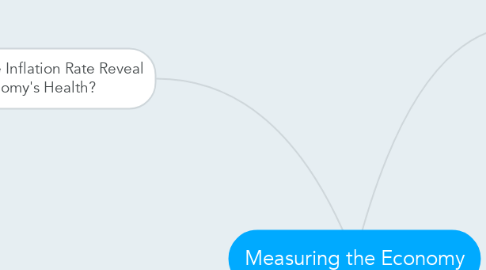
1. What Does the Inflation Rate Reveal About an Economy's Health?
1.1. 1: Germany experienced hyperinflation after World War I
1.2. 2: CPI = Consumer Price Index
1.2.1. Price index = a measure of the average change in price of a type of good over time
1.3. 3: Old farts complaining about rising prices need to know the difference between nominal and real cost of living
1.3.1. Nominal cost of living: the cost in current dollars of all the basic goods and services needed by the average consumer
1.3.2. Real Cost of Living: the cost in constant dollars of all the basic goods and services needed by the average consumer; the nominal cost of living adjusted for inflation
1.4. 4: Hyperinflation can result in barely any value to the currency
1.4.1. Creeping inflation is the usual gradual inflation to be expected in the economy
1.5. Inflation Rate = the percentage increase in the average price level of goods and services from one month or year to the next
2. How does the Business Cycle Relate the Economic Health?
2.1. 1: Business cycles can be seen as periods of "boom and bust"
2.1.1. Expansion: a period of economic growth
2.1.2. Peak: the highest point of an expansion, or period of economic growth; a peak is followed by economic decline
2.1.3. Contraction: a period of general economic decline marked by falling GDP and rising unemployment
2.1.4. Trough: the lowest point of a contraction, or period of economic decline; a trough is followed by economic growth
2.2. 2: Economies can shrink from a negative shock, a rise in interest rates, and a shortage of raw materials
2.2.1. leading economic indicators: measures that consistently rise or fall several months before an expansion or a contraction begins
2.2.2. lagging economic indicators: measures that consistently rise or fall several months after an expansion or contraction begins
2.3. 3: More spending and borrowing = good sign for the economy
2.4. 4: Business cycles are unpredictable
3. How do Economists Measure the Size of an Economy?
3.1. 1: GDP is essential for comparing economies
3.1.1. GDP = Gross Domestic Product: the market value of all final goods and services produced within a country during a given period of time
3.1.1.1. Final Good: Made for immediate consumption rather than as a part of another whole
3.2. 2: The Bureau of Economic Analysis is how the government knows what's going on with its economy.
3.3. 3: C + I + NX = GDP
3.4. 4: Nominal and Real GDP are different and it's important to know the difference when comparing across ages.
3.4.1. Real GDP = GDP adjusted for inflation
4. What does the Unemployment Rate Tell Us About an Economy's Health?
4.1. 1: Full time students and those not looking for a career are not considered Unemployed
4.2. 2: BLS = Bureau of Labor Statistics
4.3. 3: Structural Unemployment is worse than Frictional Unemployment
4.3.1. Structural Unemployment: when people who are seeking work are unable to obtain it, often from technological advances taking jobs
4.3.2. Frictional Unemployment: natural unemployment, when people are between jobs
4.3.2.1. Natural rate of unemployment: the percentage of the labor force without work when the economy is at full employment; a condition in which the economy is strong and there is no cyclical unemployment
4.4. 4: Unemployment rate is fairly accurate in measuring the health of an economy
4.5. Types of workers
4.5.1. Discouraged Workers = unemployed workers who have ceased to look for work; discouraged workers are not considered part of the labor force and are not factored into the unemployment rate
4.5.2. Involuntary Part-Time Workers = people who settle for part-time employment because they are unable to find full-time work
